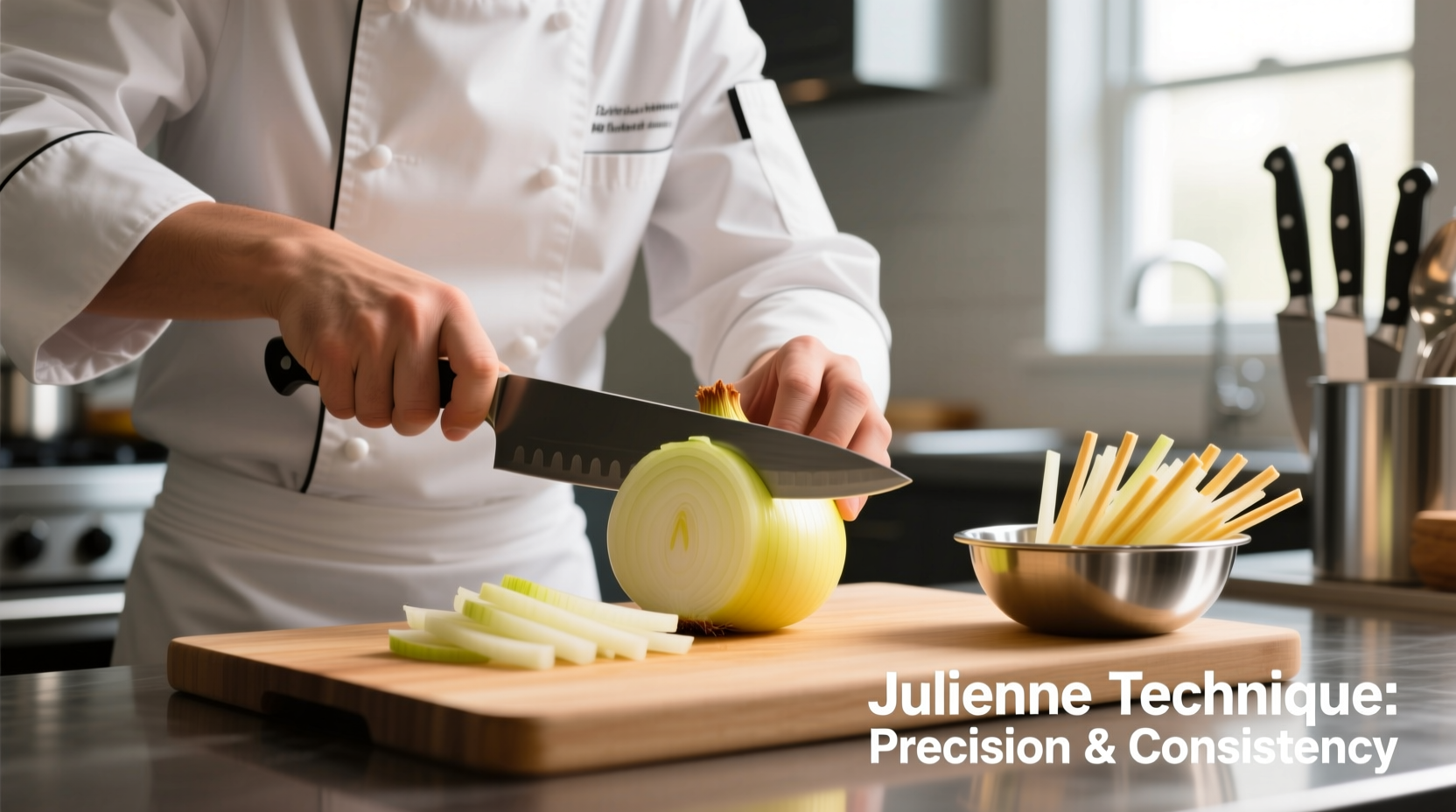Understanding the Julienned Onion Technique
When you master the art of julienning onions, you unlock a fundamental culinary skill used by professional chefs worldwide. This precise cut transforms ordinary onions into elegant, uniform strips that cook evenly and enhance both the visual appeal and texture of your dishes. Unlike standard slicing, the julienne cut creates thin matchstick pieces that maintain their structure during cooking while maximizing surface area for flavor development.
Why Julienne Onions? Culinary Advantages Explained
The julienne cut offers distinct advantages that make it indispensable in professional and home kitchens. When onions are cut this way, they provide consistent cooking results because each piece has the same dimensions, preventing some pieces from burning while others remain undercooked. This precision cut also creates maximum surface area for caramelization while maintaining structural integrity—critical for dishes where texture matters.
According to the Culinary Institute of America's knife skills curriculum, the julienne cut falls under the category of "fine cuts" that demonstrate a cook's technical proficiency. Professional chefs consistently use this technique because it allows onions to integrate seamlessly into dishes without overwhelming other ingredients.
Essential Tools for Perfect Onion Juliennes
While you can julienne onions with basic kitchen tools, having the right equipment makes the process safer and more efficient:
- Sharp chef's knife (8-10 inch): A sharp blade prevents slipping and ensures clean cuts
- Stable cutting board: Wood or composite boards provide the best grip
- Bowl of ice water (optional): Helps reduce tearing while cutting
- Non-slip mat (optional): Keeps your cutting board securely in place
Professional chefs recommend using a Japanese-style gyuto knife for precision work, but a quality Western chef's knife works perfectly for home cooks learning how to julienne an onion step by step.
Step-by-Step Guide: How to Julienne an Onion Properly
Follow these professional techniques to achieve perfect julienned onions every time:
Preparation Stage
- Chill the onion in the refrigerator for 30 minutes before cutting (reduces tearing)
- Trim both ends of the onion and remove the outer skin
- Cut the onion in half vertically through the root end
- Place each half flat-side down on your cutting board
Cutting Technique
- Make vertical slices parallel to the root end, spacing them 1/8 inch apart
- Rotate the onion 90 degrees and make horizontal cuts from the top toward (but not through) the root end
- Finally, slice downward through the onion to create uniform matchstick pieces
- Discard the root end piece containing the remaining core
| Cut Type | Dimensions | Best For |
|---|---|---|
| Julienne | 1/8" x 1/8" x 2" | Stir-fries, garnishes, salads |
| Matchstick | 1/4" x 1/4" x 2" | Hearty stir-fries, slaws |
| Brunoise | 1/8" cubes | Sauces, soups, dices |
This USDA food safety guideline reminds us that proper knife skills not only improve food quality but also reduce kitchen accidents. Always keep your fingers curled away from the blade and maintain a firm grip on the onion.
Avoiding Common Julienned Onion Mistakes
Even experienced home cooks make these errors when attempting the julienne cut:
- Inconsistent sizing: Varying thickness leads to uneven cooking
- Cutting through the root end: Causes pieces to separate prematurely
- Dull knife usage: Creates ragged edges and increases tearing
- Improper onion selection: Soft or sprouting onions don't hold the cut well
Professional chefs emphasize that the root end serves as your anchor point—never cut completely through it until the final step. This technique maintains the onion's structure during the cutting process, ensuring uniform strips.

Best Culinary Applications for Julienned Onions
Certain cooking methods particularly benefit from the precise dimensions of julienned onions:
Stir-Fries and Quick Sautés
The thin strips cook rapidly and evenly in high-heat applications. In Asian cuisine, julienned onions work beautifully in dishes like beef stir-fry where they should soften but maintain some texture. The cut allows them to integrate with other julienned vegetables like carrots and bell peppers for professional-looking vegetable medleys.
Raw Applications and Garnishes
For salads, sandwiches, and as garnishes, julienned onions provide visual appeal without overwhelming bites. Soak them briefly in ice water to mellow their sharpness while maintaining their elegant shape. This technique works particularly well for red onions in Mexican cuisine and French onion salads.
Pickling and Preserving
The uniform size ensures consistent penetration of pickling liquids. Julienned onions make beautiful additions to quick-pickled vegetable mixes that accompany grilled meats or sandwiches.
Storage Tips for Cut Onions
Proper storage maintains both food safety and quality:
- Store in an airtight container in the refrigerator
- Use within 3-4 days for best quality
- Place a damp paper towel in the container to maintain moisture
- Keep away from strongly scented foods to prevent odor transfer
The USDA Food Safety and Inspection Service recommends consuming cut onions within four days to minimize food safety risks. For longer storage, freeze julienned onions on a baking sheet before transferring to freezer bags.
When Not to Use Julienned Onions
Understanding context boundaries helps you choose the right cut for each application:
- Soups and stews: Larger dice holds up better in long-cooking liquids
- Caramelized onions: Slices create better texture for slow cooking
- Onion rings: Requires crosswise slices for proper ring formation
- Onion soup gratinée: Traditional preparation uses sliced onions
Professional chefs know that matching the cut to the cooking method is essential for optimal results. The julienne cut shines in applications requiring quick cooking and visual presentation, while other cuts better serve different culinary purposes.











 浙公网安备
33010002000092号
浙公网安备
33010002000092号 浙B2-20120091-4
浙B2-20120091-4